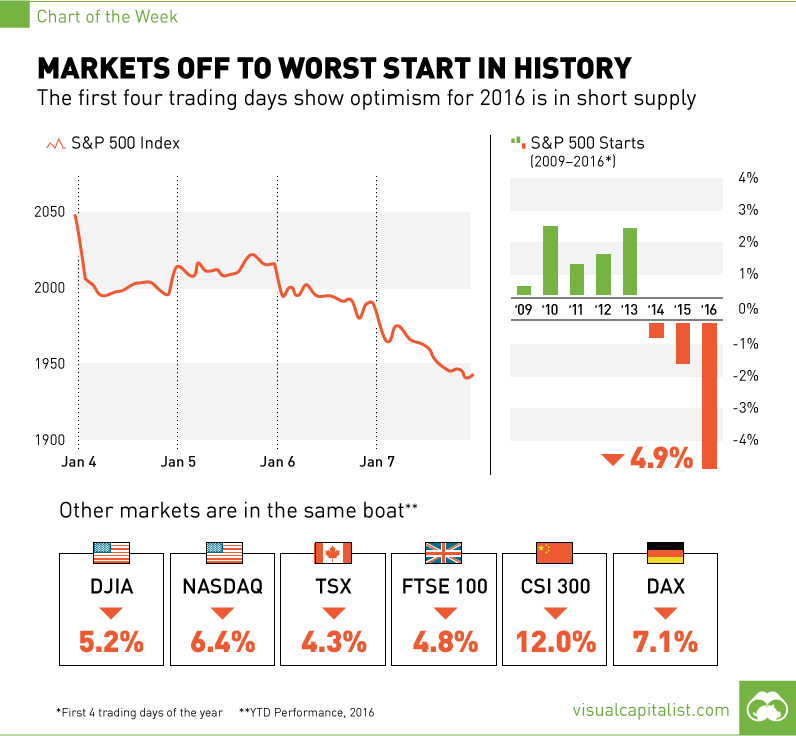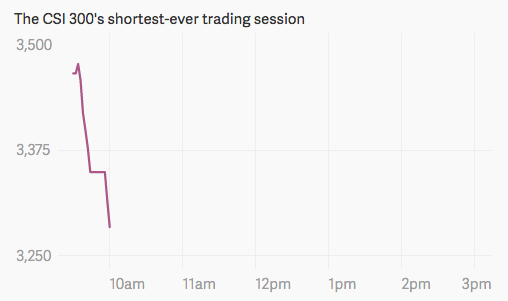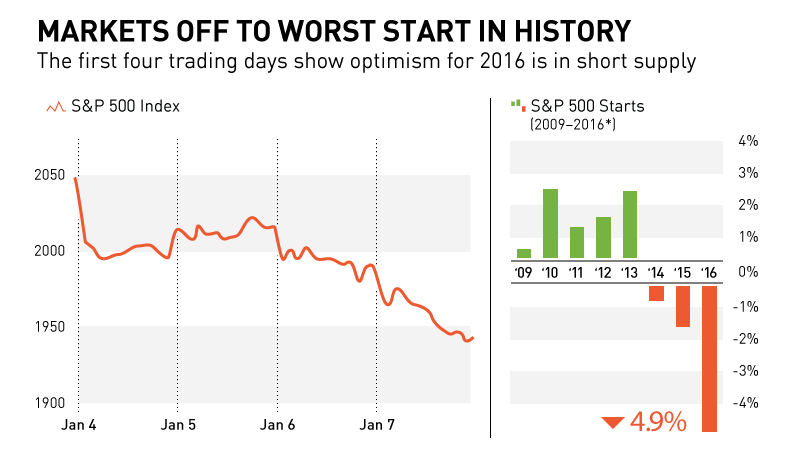Global Stock Markets Off to Worst Start in History [Chart]
The first four trading days show optimism for 2016 is in short supply.
The Chart of the Week is a weekly Visual Capitalist feature on Fridays. In our review of the economic events of 2015, we noted that the simple turning of a calendar page does not rectify the problems of the previous year. The first week of trading on major exchanges has made this even more clear.
China’s Rough Start
China kicked off the volatility this week with multiple devaluations of the yuan to reduce the strain on its foreign reserves, after burning through $120 billion in the month of December. In reaction to this news, as well as the updated manufacturing data out of China at the beginning of the week, the Chinese stock market plunged to start 2016. The “blue chip” CSI 300 index fell 7% on Monday to trigger a market intervention mechanism that halted trading. On Thursday the problems continued when the market opened down 5% almost instantly, triggering the same mechanism to provide a 15 minute trading break. Markets re-opened, plunged again, and got halted for the rest of the day. Here’s what that whole 29 minute session looked like on Thursday, including the 15 minute break:
This morning, the yuan was strengthened and it had a semi-calming effect. The CSI 300 finished up Friday’s trading in positive territory, but it is still down -9.9% for the first complete week of 2016.
The Spillover Effect
The whiplash from China’s tumultuous market was enough to put other global markets in a tizzy. This week’s Chart of the Week shows the first four days of trading on major world markets. The S&P 500 and Dow Jones Industrial Average both opened 2016 with their worst four-day starts in history. The Nasdaq also was also down 6.4% in the first four days of trading, which took it into correction territory. Canada’s TSX continued on its 19% decline since April 2015 and European markets have been hard-hit as well. Germany’s DAX was down 7.1% to start the year, and the FTSE 100 declined 4.8%. Meanwhile, crude oil (WTI) is now $33, which is its lowest price in 14 years.
Yearly Starts Trending Worse
Another point we noted in the chart above is that the starts for the S&P 500 have been trending more towards negative territory each year since the Financial Crisis. In recent times, it seems investors are starting each new year more anxious to pull the “sell” trigger. Proceed with caution in 2017.
on The good news is that the Federal Reserve, U.S. Treasury, and Federal Deposit Insurance Corporation are taking action to restore confidence and take the appropriate measures to help provide stability in the market. With this in mind, the above infographic from New York Life Investments looks at the factors that impact bonds, how different types of bonds have historically performed across market environments, and the current bond market volatility in a broader context.
Bond Market Returns
Bonds had a historic year in 2022, posting one of the worst returns ever recorded. As interest rates rose at the fastest pace in 40 years, it pushed bond prices lower due to their inverse relationship. In a rare year, bonds dropped 13%.
Source: FactSet, 01/02/2023.
Bond prices are only one part of a bond’s total return—the other looks at the income a bond provides. As interest rates have increased in the last year, it has driven higher bond yields in 2023.
Source: YCharts, 3/20/2023.
With this recent performance in mind, let’s look at some other key factors that impact the bond market.
Factors Impacting Bond Markets
Interest rates play a central role in bond market dynamics. This is because they affect a bond’s price. When rates are rising, existing bonds with lower rates are less valuable and prices decline. When rates are dropping, existing bonds with higher rates are more valuable and their prices rise. In March, the Federal Reserve raised rates 25 basis points to fall within the 4.75%-5.00% range, a level not seen since September 2007. Here are projections for where the federal funds rate is headed in 2023:
Federal Reserve Projection*: 5.1% Economist Projections**: 5.3%
*Based on median estimates in the March summary of quarterly economic projections.**Projections based on March 10-15 Bloomberg economist survey. Together, interest rates and the macroenvironment can have a positive or negative effect on bonds.
Positive
Here are three variables that may affect bond prices in a positive direction:
Lower Inflation: Reduces likelihood of interest rate hikes. Lower Interest Rates: When rates are falling, bond prices are typically higher. Recession: Can prompt a cut in interest rates, boosting bond prices.
Negative
On the other hand, here are variables that may negatively impact bond prices:
Higher Inflation: Can increase the likelihood of the Federal Reserve to raise interest rates. Rising Interest Rates: Interest rate hikes lead bond prices to fall. Weaker Fundamentals: When a bond’s credit risk gets worse, its price can drop. Credit risk indicates the chance of a default, the risk of a bond issuer not making interest payments within a given time period.
Bonds have been impacted by these negative factors since inflation started rising in March 2021.
Fixed Income Opportunities
Below, we show the types of bonds that have had the best performance during rising rates and recessions.
Source: Derek Horstmeyer, George Mason University 12/3/2022. As we can see, U.S. ultrashort bonds performed the best during rising rates. Mortgage bonds outperformed during recessions, averaging 11.4% returns, but with higher volatility. U.S. long-term bonds had 7.7% average returns, the best across all market conditions. In fact, they were also a close second during recessions. When rates are rising, ultrashort bonds allow investors to capture higher rates when they mature, often with lower historical volatility.
A Closer Look at Bond Market Volatility
While bond market volatility has jumped this year, current dislocations may provide investment opportunities. Bond dislocations allow investors to buy at lower prices, factoring in that the fundamental quality of the bond remains strong. With this in mind, here are two areas of the bond market that may provide opportunities for investors:
Investment-Grade Corporate Bonds: Higher credit quality makes them potentially less vulnerable to increasing interest rates. Intermediate Bonds (2-10 Years): Allow investors to lock in higher rates.
Both types of bonds focus on quality and capturing higher yields when faced with challenging market conditions.
Finding the Upside
Much of the volatility seen in the banking sector was due to banks buying bonds during the pandemic—or even earlier—at a time when interest rates were historically low. Since then, rates have climbed considerably. Should rates moderate or stop increasing, this may present better market conditions for bonds. In this way, today’s steep discount in bond markets may present an attractive opportunity for price appreciation. At the same time, investors can potentially lock in strong yields as inflation may subside in the coming years ahead. Learn more about bond investing strategies with New York Life Investments.






























